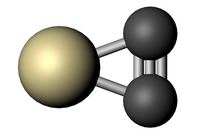|
SiC2 is a cyclic molecule with a fairly low barrier
to linearity which is probably responsible for the large
centrifugal distortion effects, especially in excited
vibrational states involving excitation of v3.
Version 3 substantially revises versions 1 from
Aug. 2007 and Jan. 2008 and 2 from Aug. 2010.
The parameters have been taken from
(1) H. S. P. Müller, J. Cernicharo,
M. Agúndez, L. Decin, P. Encrenaz,
J. C. Pearson, D. Teyssier, and L. B. F. M. Waters,
2012, J. Mol. Spectrosc., 271 50.
The observed transitions come from
(2) R. D. Suenram, F. J. Lovas, and K. Matsumura,
1989, Astrophys. J., 342, L103;
and from
(3) C. A. Gottlieb, J. M. Vrtílek, and P. Thaddeus,
1989, Astrophys. J., 343, L29.
The data from (3) display residuals between observed transition
frequencies and those calculated from the spectroscopic
parameters that frequently exceed the reported uncertainties.
In order to account for this, the uncertainties reported in (3)
have been multiplied by 1.5 as has been done in the previous
entries.
In addition, extensive transition frequencies were taken
from astronomical observations described in (1)
and from
(4) J. Cernicharo, M. Guélin, and
C. Kahane,
2000, Astron. Astrophys. Suppl., 142, 181.
Lines from (1) and (4) have not been merged.
Predictions of transitions with uncertainties larger than
1.0 and 5 MHz should be viewed with some and great
caution, respectively.
The largest uncertainty displayed is 999.9999 MHz.
The dipole moment was reported in (2).
NOTE: The partition function takes
into account the ground vibrational state only. However,
contributions of excited vibrational states to
the partition function are available. These extend to
v3 =$nbsp;4 since Aug. 2015.
For corrections much higher than 200 K, a
list of vibrational energies is also available.
|
